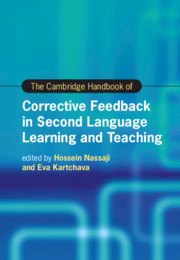Book contents
- The Cambridge Handbook of Corrective Feedback in Second Language Learning and Teaching
- Cambridge Handbooks in Language and Linguistics
- The Cambridge Handbook of Corrective Feedback in Second Language Learning and Teaching
- Copyright page
- Contents
- Figures
- Tables
- Contributors
- Acknowledgments
- Introduction Corrective Feedback in Second Language Teaching and Learning
- Part I Theoretical Perspectives on Corrective Feedback
- Part II Methodological Approaches in the Study of Corrective Feedback
- Part III Different Delivery Modes of Corrective Feedback
- Part IV Feedback Provider, Feedback Intensity, and Feedback Timing
- Part V Corrective Feedback and Language Skills
- Part VI Contexts of Corrective Feedback and Their Effects
- Part VII Learners’ and Teachers’ Feedback Perspectives, Perceptions, and Preferences
- Part VIII Individual Differences, Tasks, and Other Language- and Learner-Related Factors
- 30 Age and Corrective Feedback
- 31 Gender Effects
- 32 Feedback, Aptitude, and Multilingualism
- 33 Corrective Feedback and Affect
- 34 Corrective Feedback, Developmental Readiness, and Language Proficiency
- 35 Corrective Feedback and Grammatical Complexity: A Research Synthesis
- 36 The Role of Task in the Efficacy of Corrective Feedback
- Index
- References
33 - Corrective Feedback and Affect
from Part VIII - Individual Differences, Tasks, and Other Language- and Learner-Related Factors
Published online by Cambridge University Press: 26 February 2021
- The Cambridge Handbook of Corrective Feedback in Second Language Learning and Teaching
- Cambridge Handbooks in Language and Linguistics
- The Cambridge Handbook of Corrective Feedback in Second Language Learning and Teaching
- Copyright page
- Contents
- Figures
- Tables
- Contributors
- Acknowledgments
- Introduction Corrective Feedback in Second Language Teaching and Learning
- Part I Theoretical Perspectives on Corrective Feedback
- Part II Methodological Approaches in the Study of Corrective Feedback
- Part III Different Delivery Modes of Corrective Feedback
- Part IV Feedback Provider, Feedback Intensity, and Feedback Timing
- Part V Corrective Feedback and Language Skills
- Part VI Contexts of Corrective Feedback and Their Effects
- Part VII Learners’ and Teachers’ Feedback Perspectives, Perceptions, and Preferences
- Part VIII Individual Differences, Tasks, and Other Language- and Learner-Related Factors
- 30 Age and Corrective Feedback
- 31 Gender Effects
- 32 Feedback, Aptitude, and Multilingualism
- 33 Corrective Feedback and Affect
- 34 Corrective Feedback, Developmental Readiness, and Language Proficiency
- 35 Corrective Feedback and Grammatical Complexity: A Research Synthesis
- 36 The Role of Task in the Efficacy of Corrective Feedback
- Index
- References
Summary
Affect has been one of the most neglected areas in L2 research with the possible exception of language anxiety. This overall lack of scholarly attention to affect appears to be even more evident in corrective feedback (CF) research. This chapter discusses this relatively under-explored area, describing empirical research conducted so far in relation to the role of affective variables in CF-driven L2 learning. Given the scarcity of relevant research and a space limit, the chapter focuses mainly on language anxiety, learner beliefs/attitudes, emotions, and other related issues (e.g., motivation, self-efficacy). The brief overview of research illustrated in this chapter suggests that affect mediates L2 learning processes involving CF, and that learners’ affective states are often influenced by teacher feedback. Findings also indicate that L2 learners experience changes in affective domains, which in turn lead to varying degrees of intra-individual variability in their perceptions of CF. Nevertheless, the current state of affairs does not offer more than a potential link between CF and affective variables, and, of course, is inconclusive in terms of the extent to which these seemingly important affective variables influence the way CF contributes to L2 learning process and overall development.
Keywords
Information
- Type
- Chapter
- Information
- The Cambridge Handbook of Corrective Feedback in Second Language Learning and Teaching , pp. 713 - 732Publisher: Cambridge University PressPrint publication year: 2021
References
Accessibility standard: Unknown
Why this information is here
This section outlines the accessibility features of this content - including support for screen readers, full keyboard navigation and high-contrast display options. This may not be relevant for you.Accessibility Information
- 2
- Cited by
